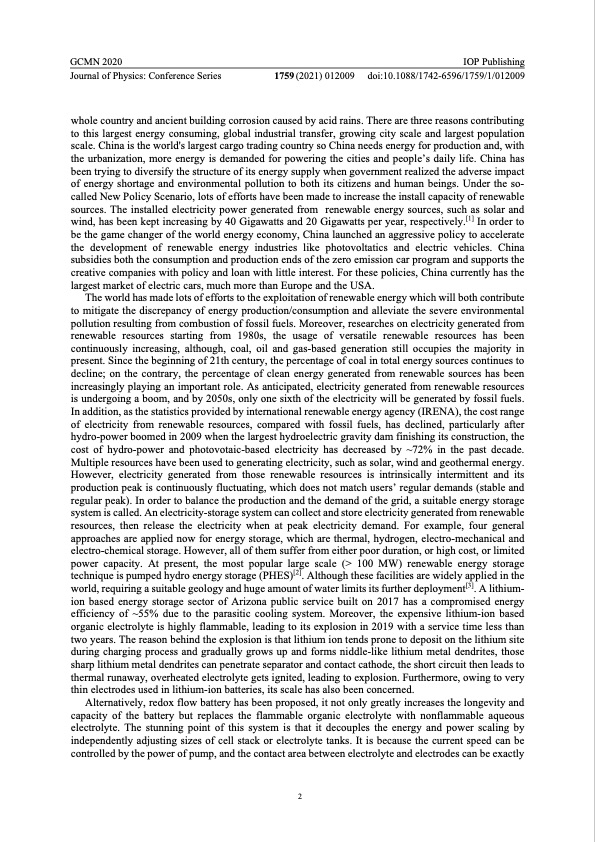
PDF Publication Title:
Text from PDF Page: 003
GCMN 2020 IOP Publishing Journal of Physics: Conference Series 1759 (2021) 012009 doi:10.1088/1742-6596/1759/1/012009 whole country and ancient building corrosion caused by acid rains. There are three reasons contributing to this largest energy consuming, global industrial transfer, growing city scale and largest population scale. China is the world's largest cargo trading country so China needs energy for production and, with the urbanization, more energy is demanded for powering the cities and people’s daily life. China has been trying to diversify the structure of its energy supply when government realized the adverse impact of energy shortage and environmental pollution to both its citizens and human beings. Under the so- called New Policy Scenario, lots of efforts have been made to increase the install capacity of renewable sources. The installed electricity power generated from renewable energy sources, such as solar and wind, has been kept increasing by 40 Gigawatts and 20 Gigawatts per year, respectively.[1] In order to be the game changer of the world energy economy, China launched an aggressive policy to accelerate the development of renewable energy industries like photovoltatics and electric vehicles. China subsidies both the consumption and production ends of the zero emission car program and supports the creative companies with policy and loan with little interest. For these policies, China currently has the largest market of electric cars, much more than Europe and the USA. The world has made lots of efforts to the exploitation of renewable energy which will both contribute to mitigate the discrepancy of energy production/consumption and alleviate the severe environmental pollution resulting from combustion of fossil fuels. Moreover, researches on electricity generated from renewable resources starting from 1980s, the usage of versatile renewable resources has been continuously increasing, although, coal, oil and gas-based generation still occupies the majority in present. Since the beginning of 21th century, the percentage of coal in total energy sources continues to decline; on the contrary, the percentage of clean energy generated from renewable sources has been increasingly playing an important role. As anticipated, electricity generated from renewable resources is undergoing a boom, and by 2050s, only one sixth of the electricity will be generated by fossil fuels. In addition, as the statistics provided by international renewable energy agency (IRENA), the cost range of electricity from renewable resources, compared with fossil fuels, has declined, particularly after hydro-power boomed in 2009 when the largest hydroelectric gravity dam finishing its construction, the cost of hydro-power and photovotaic-based electricity has decreased by ~72% in the past decade. Multiple resources have been used to generating electricity, such as solar, wind and geothermal energy. However, electricity generated from those renewable resources is intrinsically intermittent and its production peak is continuously fluctuating, which does not match users’ regular demands (stable and regular peak). In order to balance the production and the demand of the grid, a suitable energy storage system is called. An electricity-storage system can collect and store electricity generated from renewable resources, then release the electricity when at peak electricity demand. For example, four general approaches are applied now for energy storage, which are thermal, hydrogen, electro-mechanical and electro-chemical storage. However, all of them suffer from either poor duration, or high cost, or limited power capacity. At present, the most popular large scale (> 100 MW) renewable energy storage technique is pumped hydro energy storage (PHES)[2]. Although these facilities are widely applied in the world, requiring a suitable geology and huge amount of water limits its further deployment[3]. A lithium- ion based energy storage sector of Arizona public service built on 2017 has a compromised energy efficiency of ~55% due to the parasitic cooling system. Moreover, the expensive lithium-ion based organic electrolyte is highly flammable, leading to its explosion in 2019 with a service time less than two years. The reason behind the explosion is that lithium ion tends prone to deposit on the lithium site during charging process and gradually grows up and forms niddle-like lithium metal dendrites, those sharp lithium metal dendrites can penetrate separator and contact cathode, the short circuit then leads to thermal runaway, overheated electrolyte gets ignited, leading to explosion. Furthermore, owing to very thin electrodes used in lithium-ion batteries, its scale has also been concerned. Alternatively, redox flow battery has been proposed, it not only greatly increases the longevity and capacity of the battery but replaces the flammable organic electrolyte with nonflammable aqueous electrolyte. The stunning point of this system is that it decouples the energy and power scaling by independently adjusting sizes of cell stack or electrolyte tanks. It is because the current speed can be controlled by the power of pump, and the contact area between electrolyte and electrodes can be exactly 2PDF Image | Emerging Aqueous Flow Batteries and Perspectives

PDF Search Title:
Emerging Aqueous Flow Batteries and PerspectivesOriginal File Name Searched:
Zhang_2021_J_Phys_Conf_Ser_1759_012009.pdfDIY PDF Search: Google It | Yahoo | Bing
Salgenx Redox Flow Battery Technology: Salt water flow battery technology with low cost and great energy density that can be used for power storage and thermal storage. Let us de-risk your production using our license. Our aqueous flow battery is less cost than Tesla Megapack and available faster. Redox flow battery. No membrane needed like with Vanadium, or Bromine. Salgenx flow battery
| CONTACT TEL: 608-238-6001 Email: greg@salgenx.com | RSS | AMP |